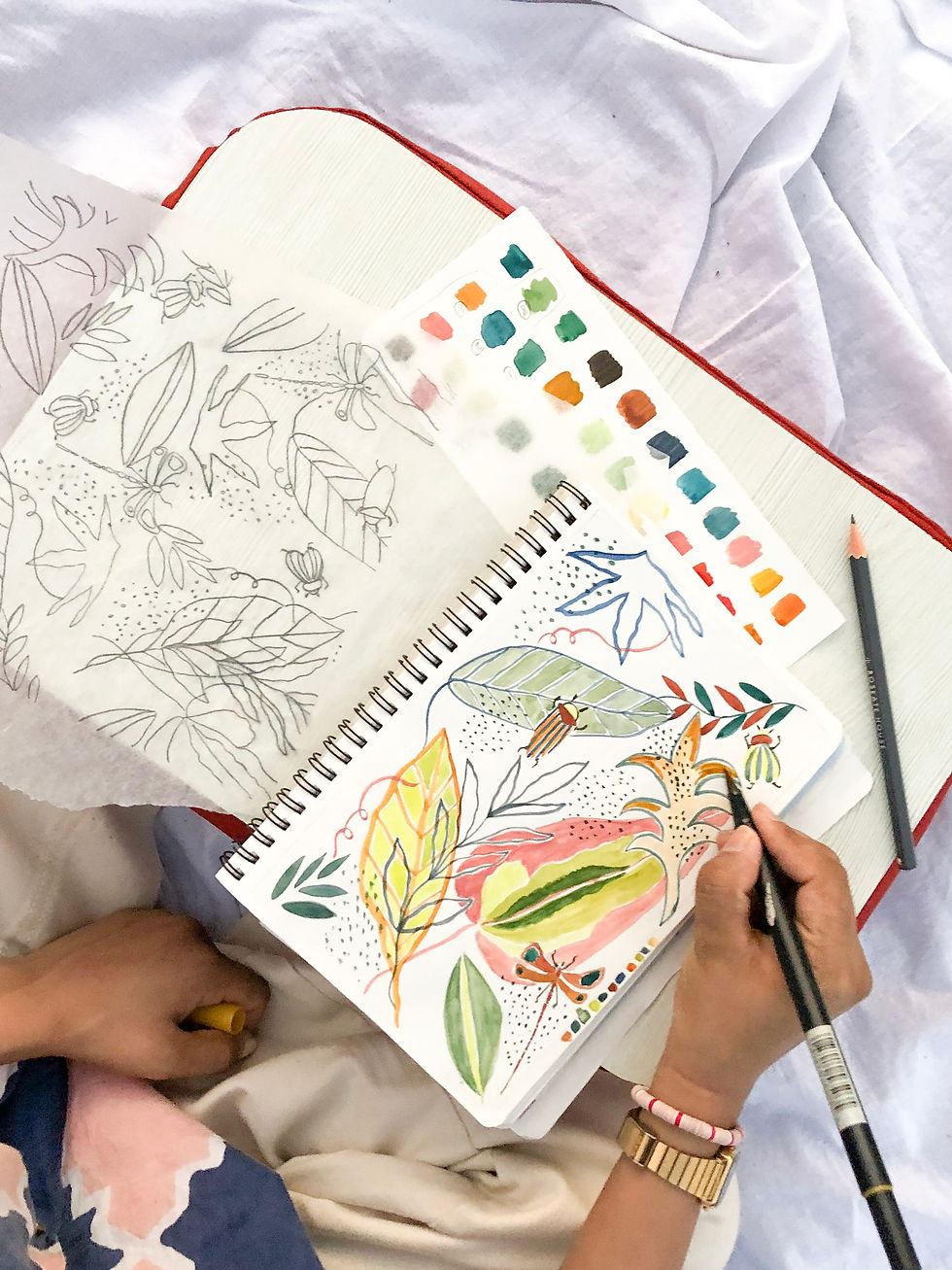Textile Experiments: Drop Cloth
- HOWS

- Jan 29, 2025
- 4 min read
Our signature, sell-out Drop Cloth Collection, now in its fourth iteration, is crafted from the drop cloth created in the Kolkata studio of a young textile artist named Aparupa; a design partner of House of Wandering Silk since 2016.
We talk to Aparupa about her journey and inspiration as a young, female Indian textile designer, and how this magical cloth came to be.
Aparupa developed a fervent interest in textiles when she was attending design school in 2011. While she dabbled in various textile mediums, particularly weaving, it wasn’t until she discovered clamp dyeing, shibori and resist dye techniques that the endless possibilities for experimentation really opened up to her. She knew she’d found her lifelong passion.


Inspired by expressionist art and everyday life, she works with block prints as a primary technique, but often merges or layers it with hand painting and various texture manipulation processes. She advocates for the beauty of the handmade; the subtle warmth and imperfections that come with the human hand, and the individual’s story that brings character to each piece of fabric she produces.
In the course of Aparupa’s work with her small team of Bengali block print masters, conducted on three 6-meter printing tables in an airy workshop in South Kolkata, splatters and flecks from the Print Master’s blocks and brush strokes work their way down into the protective layers of cloth that pad the tables and absorb pigment seepage - what is known in the industry as drop cloth.




Aparupa noticed that these layers of fabric acquired a completely accidental and unusual expression of color. The results were painterly, avant-garde even. But wearable? The coarse cotton canvas used as standard drop cloth was stiff and hard, so Aparupa swapped out the second layer of drop cloth with a soft silk crepe. She continued her job work over it, occasionally checking to see how the remnant layers of print and pigment were building.
In 2018, when Katherine, founder of House of Wandering Silk, was visiting Aparupa’s studio to discuss ongoing projects, we discovered a small cutting of this fabric: we were in love! We asked her to use a layer of silk crepe under all her work, but the process was slow. Really, really slow... We waited over a year to receive just 31 meters! Production now averages around 12 meters per month and so each fresh batch is extremely limited.
Drop cloth created this way can not be replicated or made by 'normal' production processes. We've tried to recreate the effect of the drop cloth with deliberate printing and painting in order to increase production, but the effect was totally different. Patterns looked forced and inorganic. But somehow this makes both Aparupa and us happy; it makes this drop cloth even more special and unique. We've since experimented on both linen and velvet with beautiful results.
Vol. 1 launched in 2019 and was an instant sell out. As was Vol. 2 in 2020 and Vol. 3 in 2022. We're thrilled to present you with Vol.4 in Spring 2025!



In discussion with Aparupa about her design process.
House of Wandering Silk (HOWS) — What brought you to textile design?
Aparupa — I developed a passionate interest in textiles and the creation and manipulation of surfaces while I was learning and discovering the various aspects of art and design in design school. I found myself being able to enjoy, express and emote more spontaneously with textiles through their structure, tonalities, hues and shades. The interplay of the warp and weft of weaves, in varying thicknesses, quality and colour, brought to surface new textural dimensions. As I dappled with print, shibori, clamp and resist techniques, I began to enjoy the experimental outcomes of overlapping hues of multiple colours, ‘accidentally’ reproducing new hybrid tones. I realised the possibilities of expression were endless and I knew this was going to be an affair of a lifetime!
HOWS — What inspires your approach?
Aparupa — My inspirations are varied: from the incredible variety of Indian textiles to everyday musings, nature, the work of Expressionist artists and subtle Japanese aesthetics to name a few.
HOWS — How long have you been working with textiles?
Aparupa — I’ve been working with textiles since 2011 and I started my studio venture in 2014.
HOWS — What are your favourite tools to work with?
Aparupa — I love working with hands. I believe in the beauty of the handmade, the imperfections and warmth that comes with it. I work with block printing as a primary technique on fabric and often merge or layer it with hand painting and texture processes. I feel the slight colour variations or design difference add a human character to the fabric and tell an individual story.

The Hindu god, Vishwakarma, is known as the divine architect. Vishwakarma puja is generally celebrated on 17th September every year mainly in the eastern states of India. The festival is observed in factories and industrial areas as well as by artisans, craftsman, mechanics, welders and so on. Workers also worship their tools on this day and shops and factories usually remain closed. Following the puja, a feast is prepared which is then eaten by workers and their families. All block print and weaving workshops celebrate this day in West Bengal.






































Comments